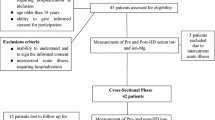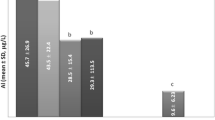Abstract
A 6-mo longitudinal study of 48 hemodialysis patients (HPs) with chronic renal failure was performed. Three blood samplings were done. Samples of whole blood from each patient were collected during hemodialysis sessions after passing through the artificial kidney. Zinc and copper levels were measured by atomic absorption spectrometry. Additionally, 36 biochemical indexes were evaluated during the study. Fifty-two healthy matched controls were also considered. Mean serum zinc and copper concentrations in HPs were significantly decreased (Zn) and increased (Cu), when compared with healthy controls (p<0.01). Zinc concentrations found in the first and second blood samplings from patients were significantly lower than those measured for the third sampling (p<0.01). The etiology of chronic renal failure influenced the statistically serum Zn levels of patients (p<0.05). Serum copper levels of HPs were significantly diminished by the existence of secondary associated diseases (p<0.01). Uric acid and parathyroid hormone, and total-cholesterol and glutamic-pyruvic-transaminase levels were significantly (p<0.05) and linearly related with serum zinc and copper concentrations, respectively. From all of indexes, creatinine, direct bilirubin, magnesium, calcium, parathyroid hormone, transferrin, and albumin were statistically modified along the longitudinal study (p<0.05). Transferrin serum levels were significantly diminished in the third blood sampling, indicating the tendency toward anemia in the patients. This result is reinforced by low levels of biochemical and hematological indexes related with iron body staus.
Similar content being viewed by others
References
D. Konukoglu, M. Ercan, M. Ayaz, and S. Onen, Plasma and erythrocytes antioxidant status and trace element levels in proteinuric patients with moderate glomerular function. J. Trace Elements Med. Biol. 15, 119–122 (2001).
J. Borawski, K. Pawlak, B. Naumnik, and M. Mysliwiec, Relations between oxidative stress, hepatocyte growth factor, and liver disease in hemodialysis patients. Renal Failure 24, 825–837 (2002).
Y. M. Song and M. D. Chen, Relative reduced plasma zinc concentration in middleaged but not elderly adults in Taiwan. Biol. Trace Element Res. 103, 97–102 (2005).
P. Ar bal Kocatürk, G. ÖzelÇi Kavas, Ö. Erdeve, and Z. S. Kiar, Superoxide dismutase activity and zinc and copper concentrations in growth retardation. Biol. Trace Element Res. 102, 1–3 (2004).
C. Terres-Martos, M. Navarro-Alarcon, F. Martin-Lagos, H. Lopez-Ga de la Serrana, V. Perez-Valero, and M. C. Lopez-Martinez, Serum zinc and copper concentrations and Cu/Zn ratios in patients with hepatopathies or diabetes. J. Trace Elements Med. Biol. 12, 44–49 (1998).
J. Bober, E. Kwiatkowska, K. Ciechanowski, et al., Do trace elements modify the activity of erythrocyte sodium-proton exchanger in hemodialyzed patients? Biol. Trace Element Res. 104, 107–120 (2005).
M. Bonomini, P. F. Palmerieri, M. Evangelista, V. Manfrini, and A. Albertazzi, Zinc-mediated lymphocyte energy charge modification in dialysis patients. Assaio. Trans. 37, 387–389 (1991).
K. H. Shu, Y. S. Lu, C. H. Chen, C. C. De Chen, S. H. Heces, and J. D. Lian, Lymphocyte proliferation in uremic patients: correlation with zinc status, J. Formos. Med. Assoc. 92, 1017–1020 (1993).
S. Turk, S. Bozfakioglu, S. T. De Ecder, et al., Effects of the zinc supplementation in the immune system and in the response to the polyvalent vaccine of the influenza in haemodialysis patients, Int. J. Artif. Organs 21, 274–278 (1998).
A. Matson, M. Wright, A. Oliver, et al., Zinc supplementation at conventional doses does not improve the disturbance of taste perception in hemodialysis patients, Renal Nutr. 13, 224–228 (2003).
M. F. Chen, C. L. Chang, and S. Y. Liou, Increase in resting levels of superoxide anion in the whole blood patients on chronic hemodialysis, Blood Purif. 16, 290–300 (1998).
D. B. Milne DB, C. D. Davis, and F. H. Nielsen, Low dietary zinc alters indices of copper function and status in postmenopausal women, Nutrition 17, 701–708 (2001).
E. D. Harris, Zinc and copper: evidence for interdependence, not antagonism, Nutrition 17, 734 (2001).
M. M. Berger, A. Shenkin, J. P. Revelly, et al., Copper, selenium, zinc and thiamine balance continuous venovenous hemodiafiltration in critically ill patients, Am. J. Clin. Nutr. 80, 410–416 (2004).
F. Martín-Lagos, M. Navarro-Alarcón, C. Terrés-Martos, H. López-Ga de la Serrana, and M. C. López, Serum zinc levels in healthy subjects from Southeastern Spain, Biol. Trace Element Res. 61, 51–60 (1998).
F. Martín-Lagos, M. Navarro-Alarcón, C. Terrés-Martos, H. López-Ga de la Serrana, V. Pérez-Valero, and M. C. López, Zinc and copper concentrations in serum from Spanish women during pregnancy, Biol. Trace Element Res. 61, 61–70 (1998).
C. Terres-Martos, M. Navarro-Alarcon, F. Martin-Logos, H. Lopez-Ga de la Serrana, and M. C. Lopez-Martinez, Determination of copper levels in serum of healthy subjects by atomic absorption spectrometry, Sci. Total Environ. 198, 97–103 (1997).
S. K. Mahajan, E. M. De Bowersox, D. L. Centeno, et al., Factors underlying abnormal zinc metabolism in uremia. Kidney Int. 268, 269–273 (1989).
K. Y. Hung, C. Y. Ho, Y. M. Kuo, et al., Trace elements burden in geriatric hemodialysis patients: a prosective multicentre collaborative study, Int J. Artif. Organs 20, 553–556 (1997).
S. J. Hwang, J. M. Chang, S. L. Lee, J. H. Tsai, and Y. H. Lai, Short and long term uses of calcium acetate do not change hair and serum zinc concentrations in hemodialysis patients, Scand. J. Clin. Lab. Invest. 59, 83–87 (1999).
J. W. Huang, K. Y. Hung, S. H. Lee, et al., Trace elements in blood and dialysate among continuous ambulatory peritoneal dialysis patients: a prospective, multicenter collaborative study, Dialysis Transplant. 29, 62 (2000).
M. E. Yilmaz, M. Kiraz, and I. H. Kara, The evaluation of serum zinc and copper levels in hemodialysis patients in souhteast Turkey, Dialysis Transplant. 29, 718 (2000).
K. Kalantas-Zadeh and J. D. Kopple, Trace elements and vitamins in maintenance dialysis patients, Adv. Renal Replace. Ther. 10, 170–182 (2003).
R. C. Ribeiro, V. S. Sales, F. de A. Neves, S. Draibe, and J. Brandao-Neto, Effects of zinc on cell-mediated immunity in chronic hemodialysis patients, Biol. Trace Element Res. 98, 209–218 (2004).
K. Sriram and G. Abraham, Loss of zinc and selenium does not occur trough peritoneal dialysis, Nutrition 16, 1047–1051 (2000).
J. D. Bogden, E. Zadzielski, B. Weiner, J. M. Oleske, and A. Aviv, Release of some trace metals from disposable coils during hemodialysis, Am. J. Clin. Nutr. 36, 403–409 (1982).
L. M. Blendis, M. Ampil, D. R. Wilson, et al., The importance of dietary protein in the zinc deficiency of uremia, Am. J. Clin. Nutr. 34, 2658–2661 (1981).
D. Van Renterghem, R. Cornelis, L. Mees, and R. Vanholder, The effect of adding Br or Zn supplements to the dialysate on the concentrations of Br and Zn in the blood of hemodialysis patients, J. Trace Elements Electrolyte Health Dis. 6, 105–109 (1992).
S. Komindr, J. Thirawitayakom, S. Taechangam, O. Puchaiwatananon, S. Songchisomboon, and S. Domrongkitchaiporn, Nutritional status in chronic hemodialysis patients, Biomed. Environ. Sci. 9, 256–262 (1996).
T. Zima, V. Tesar, O. Mestek, and K. Nemecek, Trace elements in end-stage renal disease. Clinical implication of trace elements, Blood Purif. 17, 187–198 (1999).
O. Hosokawa and O. Yoshida, Effects of erythropoietin on trace elements in patients with chronic renal failure undergoing hemodialysis, Nephron 65, 414–417 (1993).
S. Da Cunha, F. Manes Albanesi Filho, D. Senra Antelo, and M. Miranda de Souza, Serum sample levels of selenium and copper in healthy volunteers living in Rio de Janeiro, Sci. Total Environ. 301, 51–54 (2003).
J. H. Sondheirmer, S. K. Mahajan, D. L. Centeno, et al., Elevated plasma copper in chronic renal failure, Am. J. Clin. Nutr. 47, 896–899 (1988).
C. Agenet C. Brugere, and J. P. Reynier, Plasma and intraerythrocytic concentrations of copper and zinc in uremic patients treated by periodic hemodialysis, Ann. Biol. Clin. 47, 493–496 (1989).
B. Kaminska-Galwas, W. Grzeszczak, A. Jedryczko, and J. L. Pachelski, Levels of Zn, Cu, Ni and Se in the serum of treated haemoldilysis patients. Influence of the therapy with erythropoyetin, Pol. Arch. Med. Wewn. 89, 368–376 (1993).
N. J. Emenaker, R. A. Disilvestro, N. S. Nahman, and S. Percival, Copper-related blood indexes in kidney dialysis patients, Am. J. Clin. Nutr. 64, 757–760 (1996).
L. Locsey and L. Papp, Study of trace elements in patients on haemodialysis, Int. Urol. Nephrol. 15, 289–295 (1983).
S. Hosokawa, H. Nishitani, T. Imai, T. Nishio, T. Tomoyoshi, and K. Sawanishi, Copper and zinc changes in chronic haemodialysis patients, Trasplant. Assoc. Eur. Renal Assoc. 21, 247–250 (1985).
T. Zima, O. Mestek, M. Nemecek, et al., Trace elements in hemodialysis and continuous ambulatory peritoneal dialysis patients, Blood Purif. 16, 253–260 (1988).
M. Navarro and R. J. Wood, Plasma changes in micronutrients following a multivitamin and mineral supplement in healthy adults, J. Am. Coll. Nutr. 22, 124–132 (2003).
C. Gamez, M. D. Ruiz-Lopez, R. Artacho, M. Navarro, A. Puerta, and C. Lopez, Serum selenium in institutionalized elderly subjects and relation to other nutritional markers, Clin. Chem. 43, 693–694 (1997).
P. A. Lopes, M. C. Santos, L. Vicente, et al., Trace element status (Se, Cu, Zn) in healthy portuguese subjects of Lisbon population: a reference study. Biol. Trace Element Res. 101, 1–18 (2004).
S. Okuyama, H. Mishina, K. Hasegawa, N. Nakano, and K. Ise, Probable atherogenic role of zinc and copper as studied in chronic hemodialysis patients, Tohoku J. Exp. Med. 138, 227–229 (1982).
J. McEnemy, C. M. Loughrey, P. T. McNamee, E. R. Trimble, and I. S. Young, Susceptibility of VLDL to oxidation in patients on regular haemodialysis, Atherosclerosis 21, 215–220 (1997).
A. Igel-Korcagova, P. Raab, K. A. Brensing, et al., Cholesterol metabolism in patients with chronic renal failire on hemodialysis, J. Nephrol. 16, 850–854 (2003).
R. D. Rohn, P. Pleban, and L. L. Jenkins, Magnesium, zinc, and cooper in plasma and blood cellular components in children with IDDM, Clin. Chim. Acta 215, 21–28 (1993).
G. Aalbers and J. P. W. Houtman, Relationships between trace elements and atherosclerosis, Sci. Tot. Environ. 43, 255–283 (1985).
I. I. Dementeva, M. I. Anchianova, S. L. Dzemesh Kevich, A. G. Iavorouskii, and L. S. Lokslin, Changes in the content of microelements: copper, zinc and iron in the blood of patients following cardiopulmonary bypass, Anesteziol. Reanimatol. 4, 50–53 (1993).
V. Panichi, D. Taccola, G. M. Rizza, et al., Ceruloplasmin and acute phase protein levels are associated with cardiovascular disease in chronic dialysis patients, J. Nephrol. 17, 715–720 (2004).
Z. Tang, Y. Wu, Q. W. Wang, et al., Clinical spectrum of diffuse crescentic glomerulonephritis in Chinese patients, Chin. Med. J. 116, 1737–1740 (2003).
Author information
Authors and Affiliations
Rights and permissions
About this article
Cite this article
Navarro-Alarcon, M., Reyes-Pérez, A., Lopez-Garcia, H. et al. Longitudinal study of serum zinc and copper levels in hemodialysis patients and their relation to biochemical markers. Biol Trace Elem Res 113, 209–222 (2006). https://doi.org/10.1385/BTER:113:3:209
Received:
Revised:
Accepted:
Issue Date:
DOI: https://doi.org/10.1385/BTER:113:3:209




